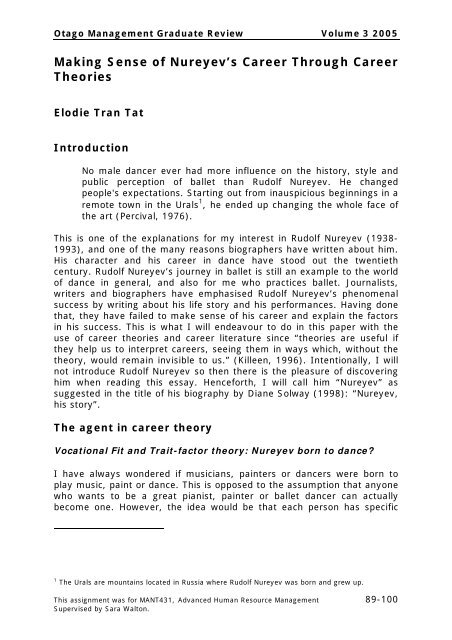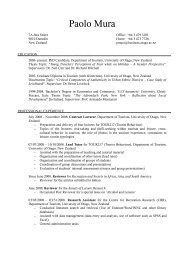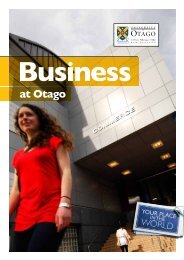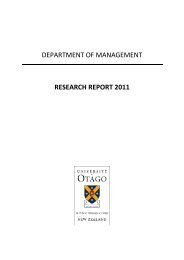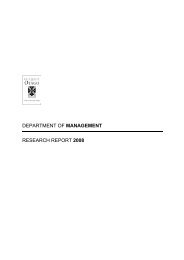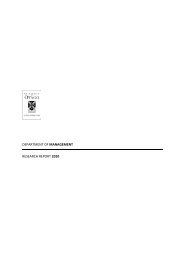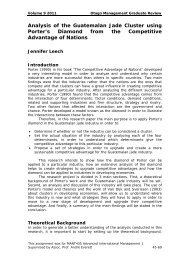Making Sense of Nureyev's Career Through Career Theories
Making Sense of Nureyev's Career Through Career Theories
Making Sense of Nureyev's Career Through Career Theories
You also want an ePaper? Increase the reach of your titles
YUMPU automatically turns print PDFs into web optimized ePapers that Google loves.
Otago Management Graduate Review Volume 3 2005<br />
<strong>Making</strong> <strong>Sense</strong> <strong>of</strong> Nureyev’s <strong>Career</strong> <strong>Through</strong> <strong>Career</strong><br />
<strong>Theories</strong><br />
Elodie Tran Tat<br />
Introduction<br />
No male dancer ever had more influence on the history, style and<br />
public perception <strong>of</strong> ballet than Rudolf Nureyev. He changed<br />
people's expectations. Starting out from inauspicious beginnings in a<br />
remote town in the Urals 1 , he ended up changing the whole face <strong>of</strong><br />
the art (Percival, 1976).<br />
This is one <strong>of</strong> the explanations for my interest in Rudolf Nureyev (1938-<br />
1993), and one <strong>of</strong> the many reasons biographers have written about him.<br />
His character and his career in dance have stood out the twentieth<br />
century. Rudolf Nureyev’s journey in ballet is still an example to the world<br />
<strong>of</strong> dance in general, and also for me who practices ballet. Journalists,<br />
writers and biographers have emphasised Rudolf Nureyev’s phenomenal<br />
success by writing about his life story and his performances. Having done<br />
that, they have failed to make sense <strong>of</strong> his career and explain the factors<br />
in his success. This is what I will endeavour to do in this paper with the<br />
use <strong>of</strong> career theories and career literature since “theories are useful if<br />
they help us to interpret careers, seeing them in ways which, without the<br />
theory, would remain invisible to us.” (Killeen, 1996). Intentionally, I will<br />
not introduce Rudolf Nureyev so then there is the pleasure <strong>of</strong> discovering<br />
him when reading this essay. Henceforth, I will call him “Nureyev” as<br />
suggested in the title <strong>of</strong> his biography by Diane Solway (1998): “Nureyev,<br />
his story”.<br />
The agent in career theory<br />
Vocational Fit and Trait-factor theory: Nureyev born to dance?<br />
I have always wondered if musicians, painters or dancers were born to<br />
play music, paint or dance. This is opposed to the assumption that anyone<br />
who wants to be a great pianist, painter or ballet dancer can actually<br />
become one. However, the idea would be that each person has specific<br />
1 The Urals are mountains located in Russia where Rudolf Nureyev was born and grew up.<br />
This assignment was for MANT431, Advanced Human Resource Management 89-100<br />
Supervised by Sara Walton.
Volume 3 2005 Otago Management Graduate Review<br />
abilities, interests and preferences or personality traits and that the most<br />
appropriate job to his/her career development should match his/her<br />
personal characteristics. This is emphasised in the notion <strong>of</strong> the personenvironment<br />
fit: “people are moulded to fit their career” (Killeen, 1996).<br />
Parsons (as cited in Inkson, 2004a) defines this notion as the vocational<br />
fit. He suggested that a choice <strong>of</strong> vocation depends upon (1) an accurate<br />
knowledge <strong>of</strong> one’s person (2) a thorough knowledge <strong>of</strong> the job<br />
specifications and (3) the ability to match the two. Then, John Holland<br />
developed the trait-and-factor theory (1985). He suggested the existence<br />
<strong>of</strong> a match between individuals and job traits, and that a close fits result<br />
in job success and satisfaction. The assumption is that “people can<br />
function and develop best and find job satisfaction in work environments<br />
that are compatible with their personalities” (Holland as cited in Johnson,<br />
2001).<br />
The trait-and-factor theory is useful to explain Nureyev’s success. Firstly,<br />
at an early age, Nureyev was interested in art and music and had a<br />
passion for dance. When he was nearly eight years old, Nureyev saw a<br />
famous Russian Ballerina performing a ballet variation. From that moment<br />
onwards, he decided to be a dancer. Secondly, he was made aware <strong>of</strong> his<br />
potential in dancing by his early dance teacher. “His natural turnout and<br />
pliant muscles, rare in a male dancer, were astounding in one who started<br />
training so late.” (Solway, 1998). He also knew about the obstacles that<br />
he might have to face; his father’s reluctance for example. Nureyev<br />
quickly learnt that being a successful dancer required hard work and<br />
perseverance. He was determined to do his best to match the standards <strong>of</strong><br />
the world <strong>of</strong> dance. The great success and international recognition<br />
Nureyev gained as well as his personal satisfaction when dancing on stage<br />
can effectively be seen as the result <strong>of</strong> the match between his traits and<br />
the characteristics <strong>of</strong> the job as a dancer, the main occupation <strong>of</strong> his life.<br />
Moreover, according to Holland, individuals are attracted to certain jobs.<br />
They choose a career that is reflective <strong>of</strong> their personality. Holland<br />
identifies six personality styles (referred to by the acronym RIASEC) and<br />
relates each <strong>of</strong> them to a specific work environment. These are<br />
represented in Figure 1. Each type is a part <strong>of</strong> an individual. Yet, one type<br />
is usually dominant. It would seem obvious that for a dancer, the<br />
dominant type would be “artistic”. Nureyev had great creative abilities.<br />
When he performed as a dancer, he added his own creative touch to the<br />
choreography he was taught. As a choreographer he created successful<br />
compositions. Nureyev made use <strong>of</strong> his social and enterprising style to<br />
guide the other dancers in their work and bring out the best in them.<br />
90
Otago Management Graduate Review Volume 3 2005<br />
Figure 1: Holland’s theory <strong>of</strong> occupational personalities<br />
(RIASEC) – 1985<br />
TYPE ACTIVITIES<br />
REALISTIC Working with things (i.e. tools and machines)<br />
INVESTIGATIVE Working with information (i.e. abstract ideas<br />
and theories)<br />
ARTISTIC Creating things<br />
SOCIAL Helping people<br />
ENTERPRISING Leading others<br />
CONVENTIONAL Organising data<br />
A tremendous inspiration … he made the work so exciting and<br />
fulfilling … He will always help any dancer who asks him, and I have<br />
a feeling that any problem I had, pr<strong>of</strong>essionally, I could always go<br />
to him and get an honest answer. (Percival, 1976)<br />
Thus, the trait-and-factor theory permits emphasis on Nureyev’s<br />
personality (e.g. attracted to dance) and his natural ability for dance. This<br />
theory then, highlights the compatibility between Nureyev’s characteristics<br />
and the world <strong>of</strong> dance. Another key way to explain Nureyev’s successful<br />
career and his match with his environment is through the psychodynamic<br />
and structural theories.<br />
The agent and the environment<br />
Psychodynamic and structural theories: Nureyev’s personality vs.<br />
environment<br />
First, within the idea <strong>of</strong> a person-environment match being previously<br />
introduced, the psychodynamic theory looks at a person’s motives that<br />
determine his/her actions in his/her career. It emphasises the role <strong>of</strong><br />
personality in career success and the role <strong>of</strong> the family in the career<br />
development <strong>of</strong> the individual (Killeen, 1996). Secondly, the structural<br />
theory deals with the influence <strong>of</strong> the individual’s environment in careers.<br />
For instance, socio-economic theories focus on the explanations and<br />
descriptions <strong>of</strong> how the culture, family background, social and economic<br />
conditions, and other external factors can influence an individual’s<br />
identity, his/her values and his/her career development (Killeen, 1996).<br />
Both the psychological theory and the structural theory can be applied to<br />
Nureyev to understand how his strong personality contributed to his<br />
success. In the case <strong>of</strong> Nureyev’s career, these two theories can be linked<br />
in two different ways.<br />
On one hand, the structural theory emphasises the role <strong>of</strong> Nureyev’s<br />
environment in strengthening his interests and motives in dance. Nureyev<br />
91
Volume 3 2005 Otago Management Graduate Review<br />
grew up in a musical and dancing environment in Russia. The Russian<br />
culture <strong>of</strong> ballet and the traditional Tartar dances contributed to the<br />
building <strong>of</strong> Nureyev’s passion for dance. The internationally recognised<br />
excellence <strong>of</strong> Russian Opera and Russian Ballet Schools influenced<br />
Nureyev in his ambitions to be a dancer. Moreover, Nureyev’s dance<br />
teacher, Alexander Pushkin, was like a father to him. Pushkin played a key<br />
role in his career development.<br />
92<br />
Rudolph was only too aware <strong>of</strong> the catch-up ahead <strong>of</strong> him and saw<br />
that Pushkin’s approval would not come easily. But he also knew<br />
that Pushkin’s approval was career-making. For the first time in his<br />
life, Rudolph felt secure in the knowledge that this training was in<br />
the best possible hands (Solway, 1998).<br />
On the other hand, Nureyev was eager to express himself and refused to<br />
be enclosed in a mould. He “didn’t fit the Kirov mold ... He was the first<br />
man to dance on high demi-pointe and the first to extend his leg high in<br />
the air.” (Solway, 1998). His paradoxical anti-conformist personality<br />
contributed to his recognition and his influence in the world <strong>of</strong> dance.<br />
Nureyev was determined to fight any ‘unfavourable’ aspects <strong>of</strong> his<br />
environment or hazards. He overcame the popular beliefs about the<br />
dancing pr<strong>of</strong>ession and career. He struggled against his father, a political<br />
<strong>of</strong>ficer in the Red Army who thought that the dancing career was not for<br />
boys. Nureyev’s father forbade him to continue the dancing classes<br />
because they affected his school results and therefore, his chance <strong>of</strong> a<br />
‘suitable’ career such as an engineer or a doctor.<br />
Like her husband, [Nureyev’s mother] had high hopes for Rudolph<br />
and imagined an entirely different career for him …The fact that<br />
their dreams were entirely at odds with those <strong>of</strong> their son would<br />
create lasting turmoil for all <strong>of</strong> them.<br />
… His mother … never encouraged his early interest in dance … In<br />
the lives <strong>of</strong> most prodigies, one needn’t look far to find a parent<br />
behind the scenes stage-managing his or her <strong>of</strong>fspring’s career.<br />
Mozart had ambitious father; Nijinsky, Yehudi Menuhin and Vladimir<br />
Horowitz 2 all had powerful mothers. What makes Nureyev’s case so<br />
unusual is that from a very early age, his progress was selfdetermined<br />
and self-propelled. […] Rudolph had to rely primarily on<br />
his own wits and wiles to advance, his methods consciously hidden<br />
from his father. (Solway, 1998)<br />
2 Nijinski (1889-1950), Yehudi Menuhin (1916-1999) and Vladimir Horowitz (1904-1989) are<br />
respectively famous Russian dancer and choregraph, violinist and pianist.
Otago Management Graduate Review Volume 3 2005<br />
Moreover, Nureyev experienced many different injuries (broken toes and<br />
ankles) which are an inevitable part <strong>of</strong> a career in ballet. But he never<br />
gave up and overcame the ‘accidents’. He kept dancing and came back on<br />
stage against medical opinion that he would never dance again. Pain and<br />
ankle problems followed him through his dancer career but his<br />
determination was stronger and led him to success.<br />
Both the psychodynamic and structural theories emphasise Nureyev’s<br />
powerful personality and its role in his career. However, there is a need<br />
for other career theories to better understand how Nureyev acted and how<br />
he made his decisions i.e. the understanding <strong>of</strong> his career development<br />
and his learning process. This is now addressed.<br />
Action in career theory<br />
Developmental theories: Nureyev - dancer, choreographer,<br />
director, actor, and conductor.<br />
Super’s theory (1957) suggests that socio-economic factors, mental and<br />
physical abilities, personality and work opportunities determine career<br />
patterns. Super identifies five related age stages over one’s life-span<br />
(Johnson, 2001). Figure 2 emphasises these steps. In Super’s model,<br />
people are expected to adapt to changes and cycle and recycle through<br />
the life stages (Blustein, 1997). The aim <strong>of</strong> these age brackets and related<br />
stages <strong>of</strong> career development is to help the agent understand and select<br />
appropriate responses and activities. Super’s theory is very useful in<br />
making sense <strong>of</strong> the different steps <strong>of</strong> Nureyev’s career even though<br />
Nureyev’s career required an adaptation <strong>of</strong> the different age brackets<br />
defined by Super (see Figure 2.). Super’s stages are not completely<br />
appropriate to artistic careers such as a musician’s career or a dancing<br />
career like Nureyev’s. Note that Super’s model does not consider the role<br />
<strong>of</strong> vocation in these specific artistic careers, which plays a key role in the<br />
early individual’s motives and development.<br />
Super also emphasises the different roles individuals play during their<br />
career. He highlights the importance given to these roles at different<br />
stages in life (see Figure 2 for Nureyev’s different roles). He maintains<br />
that the individuals seek satisfaction through work roles in which they can<br />
express themselves and develop their self-concept (Johnson, 2001).<br />
Super’s self-concept theory (1953, 1957) requires self-observation and<br />
comparison to others in order to develop oneself (Killeen, 1996). Selfesteem<br />
and self-efficacy are variables <strong>of</strong> the self-concept. They have<br />
implications for vocational behaviour and thus play a role in career<br />
development (Savickas, 1997).<br />
93
Volume 3 2005 Otago Management Graduate Review<br />
The self-concept theory is <strong>of</strong> high value because it highlights the strong<br />
concept Nureyev had <strong>of</strong> himself as well as the importance <strong>of</strong> the<br />
contribution <strong>of</strong> his self-esteem and self-efficacy to his success.<br />
94<br />
[Nureyev] didn’t show much interest in other people except as<br />
dance partners. He was quite self-focus. His only desire was to<br />
study ballet… He was just a beginner but you could see he was<br />
confident, that he had stage presence.<br />
…Rudolf’s supreme self-confidence and independence aroused<br />
indignation in a company where hierarchy, respect and servility<br />
were paramount. (Solway, 1998)<br />
Organisational behaviour and career theorists developed Super’s notion <strong>of</strong><br />
self-concept. They suggested that identification with role models is critical<br />
to individual growth and development (Erikson, 1985; Hall, 1976;<br />
Krumboltz, 1996; Schein as cited in Gibson, 2003). <strong>Career</strong> success is<br />
attributed to a person having ‘‘good role models’’ and career failure to a<br />
‘‘lack <strong>of</strong> role models’’. Krumboltz’s social learning theory or modelling<br />
theories can be applied to Nureyev to make sense <strong>of</strong> his learning process<br />
and career development. Nureyev looked up to role models because they<br />
were helpful in learning new tasks, skills, and norms (Miller & Dollard,<br />
1941; Wood & Bandura as cited in Gibson, 2003). Thus, the behavioural<br />
model emphasises how Nureyev learnt by observing the other dancers<br />
performing on the stage but not necessarily imitating their behaviour.<br />
Nureyev also studied the work <strong>of</strong> the famous choreographers Balanchine<br />
and Béjart. They served as role models and a source <strong>of</strong> inspiration when<br />
Nureyev started to create his own choreographies.<br />
Rudolph encountered his first Western ballet stars in the pages <strong>of</strong> Dance<br />
Magazine. He had role models closer at hand. Every afternoon the Kirov’s<br />
artists arrived at school for class. Rudolph rarely passed the opportunity<br />
to observe them.<br />
Krumboltz also suggests that social learning, environmental conditions<br />
and events, genetic influences and learning experiences contribute to<br />
career decision-making and development (Ettinger, 1996). The idea is<br />
that people make choices for their career according to what they have<br />
learnt. This contributes to the understanding <strong>of</strong> how and why Nureyev<br />
made decisions.
Otago Management Graduate Review Volume 3 2005<br />
Figure 2: Super’s model <strong>of</strong> life-span applied to Nureyev’s career<br />
STAGE AGES CHARACTERISTICS AGES / NUREYEV’S CAREER<br />
Growth Birth Form self-concept, 8 – Vocation. Decided to be a<br />
develop capacity, dancer.<br />
attitudes, interests and - Folk dances at school in<br />
14-15 needs.<br />
Russia.<br />
Form a general<br />
- Amateurs group ‘The<br />
understanding <strong>of</strong> the<br />
world <strong>of</strong> work.<br />
Pioneers”.<br />
Exploratory 15-24 “Try out” through 10- Academic dance lessons.<br />
classes, work<br />
15- Began as a pr<strong>of</strong>essional<br />
experience, hobbies. dancer. Served as an extra in a<br />
Collect relevant<br />
production at the opera house.<br />
information.<br />
Dance tours in Russia.<br />
20- Soloist contract. 3 years<br />
performing for the Kirov dance<br />
company.<br />
Tentative 25-44 Choice and related skill 23- Escaped to the West.<br />
Establishment development. Entry skill Asked for asylum in France<br />
building and<br />
- <strong>Career</strong> in the West. Royal<br />
stabilization through Ballet (UK).<br />
work.<br />
26 - Débuts as a<br />
choreographer.<br />
- Acted in two movies.<br />
Experience 45-64 Continual adjustment 45-51- Ballet director <strong>of</strong> the<br />
maintenance<br />
process to improve Paris Opera.<br />
position.<br />
- Still danced and created<br />
choreographies.<br />
- Conductor experience.<br />
- Declining health.<br />
Decline 65+ Reduced output, for 55- died <strong>of</strong> AIDS<br />
prepare<br />
retirement.<br />
Decision styles theories: how Nureyev made choices<br />
First, the decision–making theory supports the idea that choices can<br />
greatly influence the individual’s career development. These choices are<br />
critical decision–making points such as educational choices or job<br />
changes. Nureyev made a critical decision when he decided to stay in<br />
France when he was asked to return to his native country by the Russian<br />
authorities. This “leap to freedom” (Solway, 1998) was the beginning <strong>of</strong> a<br />
successful career in the West.<br />
And then I made it – in the longest most breath-taking leap <strong>of</strong> my<br />
whole career I landed squarely in the arms <strong>of</strong> the two inspectors. ‘I<br />
want to stay’ I gasped. ‘I want to stay’. (Solway, 1998)<br />
Secondly, Nevill (1997) suggests that different goals can be involved in<br />
decision-making. These are “pleasing his/her parents, making a lot <strong>of</strong><br />
95
Volume 3 2005 Otago Management Graduate Review<br />
money, helping people, being creative, and so forth.” The decision styles<br />
theory explains how choices are made. Killeen (1996) emphasises four<br />
different decision styles: rational, intuitive, dependent and intuitivedependent.<br />
Phillips (1997) considers the intuitive decider as a fast rational<br />
decider. The intuitive decider has the capacity for quick retrieval <strong>of</strong><br />
information or relevant information. He identifies a problem, generates a<br />
plausible solution, and integrates automatic sequences <strong>of</strong> learned<br />
behaviour and isolated parts <strong>of</strong> experience to evaluate the rightness <strong>of</strong> a<br />
rationally constructed response (Isenberg as cited in Phillips, 1997). Using<br />
intuition is useful when a decision point is approaching and it is relevant in<br />
some circumstances when a quick decisional response is necessary<br />
(Phillips, 1997). Nureyev was an intuitive decision maker characterised by<br />
a “personal sense <strong>of</strong> responsibility, reliance on feelings, fantasy, inner<br />
experience, impulsiveness” (Killeen, 1996). His decisions were not<br />
planned in advance but rather a response to a particular situation (in his<br />
dancer débuts at least). Nureyev’s decisions were made to follow one<br />
goal: dancing on stage.<br />
96<br />
Rudolph’s desire to dance far outweighed any other concerns, even<br />
his fear <strong>of</strong> his father. […]. Rudolph continued to dream <strong>of</strong> a career<br />
on stage, the only place where he felt free to express himself fully.<br />
[…] He was distinguished by his great desire to dance. (Solway,<br />
1998)<br />
The developmental theory emphasises the diversity <strong>of</strong> Nureyev’s career<br />
through a successful academic scheme. Both the psychodynamic theory<br />
and the structural theory have shown how his strong personality impacted<br />
on his career development. Now it is worth trying to classify Nureyev’s<br />
career.<br />
Traditional vs. New career<br />
What metaphor for Nureyev’s career?<br />
For the last decade, career literature has focused on the new, boundaryless<br />
or protean careers as opposed to traditional careers.<br />
On one hand, Nureyev’s career could be seen as a traditional career in<br />
dance. Nureyev’s career progression is typical <strong>of</strong> a dancer’s evolution. He<br />
climbed up the ladder, starting as a dancer to finish up as a director <strong>of</strong><br />
different operas as well as the job <strong>of</strong> a choreographer. This can be<br />
explained by the structure <strong>of</strong> a career in dance. Similar to careers in<br />
teaching or nursing, careers in dancing are standardised with nearly<br />
universal grades and schemes <strong>of</strong> career progression (Evetts, 1992).<br />
Principal dancers commonly play the role <strong>of</strong> choreographer or ballet<br />
director at the end <strong>of</strong> their career.
Otago Management Graduate Review Volume 3 2005<br />
However on the other hand, Nureyev’s career follows a new career<br />
scheme considering Inkson’s criteria (2004a) defined as mobility,<br />
discontinuity, improvisation, networks and knowledge investment.<br />
Nureyev’s career was mobile. He travelled all over the world participating<br />
in dance tours. Nureyev has become a “quick-change artist, hopping from<br />
company to company, from role to role” (Solway, 1998). His career was<br />
discontinuous; being interrupted when he was injured or when waiting for<br />
administrative regulations at his arrival in France where he asked for<br />
political asylum. His route was improvisational. He never expected to have<br />
to choose between two dance companies to work for. “I don’t know how to<br />
decide. Both the Kirov and the Bolshoi have invited me to join” (Solway,<br />
1998). Moreover, Nureyev was never shy in self-promotion and<br />
successfully built networks and his reputation widely “Networks provide<br />
contacts which assist their members to become aware <strong>of</strong>, and to get new<br />
jobs” (Inkson, 2004a).<br />
Rudolph asked Menia to introduce him to Alberto in the hope <strong>of</strong><br />
being invited to perform in Cuba…<br />
…Claire Motte introduced him to her good friend Clara Saint […].<br />
Clara Saint introduced Rudolph to her good friend Raymundo de<br />
Larrain, an aristocratic Chilean, who had just taken over the Grand<br />
Ballet du Marquis de Cuevas. (Solway, 1998)<br />
Finally, Nureyev learnt, learnt and learnt. He accumulated abilities to<br />
always perform better as a dancer and enlarge his repertoire. “I am a<br />
romantic kind <strong>of</strong> dancer. But I would like to dance modern things and to<br />
try every different way which exists” (Solway, 1998).<br />
In new careers, the agent is seen as a “reflective project, for which the<br />
individual is responsible”. “We are not what we are, but what we make <strong>of</strong><br />
ourselves.” (Giddens as cited in Collin, 1998). This reflects Nureyev’s<br />
personality and the way he built his career.<br />
“Rudolph began taking every aspect <strong>of</strong> his performance into his own<br />
hands. Along the way, he managed to transform not just each new<br />
role he danced, but the public’s perception <strong>of</strong> him”<br />
“If Covent Garden can’t provide you with work and incentive, you go<br />
and get it somewhere else. Get <strong>of</strong>f your ass; go, telephone,<br />
organize, provoke, make performances somewhere else.” [Rudolf]<br />
had decided early on never wait for opportunities. (Solway, 1998)<br />
As Collins suggests (as cited in Evetts, 1992), Nureyev’s career is to be<br />
analysed in terms <strong>of</strong> his “motivations, resources and contacts that lead<br />
from one job to another” and in terms <strong>of</strong> “a succession <strong>of</strong> personal<br />
encounters”. <strong>Making</strong> sense <strong>of</strong> Nureyev’s career implies an emphasis on<br />
the subjective aspects <strong>of</strong> his career, so strong was his determination and<br />
97
Volume 3 2005 Otago Management Graduate Review<br />
his personality. On the contrary, career literature has <strong>of</strong>ten highlighted the<br />
objective or external realm <strong>of</strong> careers to the detriment <strong>of</strong> the subjective or<br />
internal perspective (Collin, 1998). Traditional careers are <strong>of</strong>ten related to<br />
the notion <strong>of</strong> objective careers whereas new careers are expected to<br />
favour the subjective side. (Walton & Mallon, 2004). This reinforces the<br />
idea <strong>of</strong> a non-traditional career for Nureyev; the subjective being<br />
dominant.<br />
Finally, Inkson (2004b) suggests using career metaphors to increase the<br />
understanding <strong>of</strong> a career. He identifies nine metaphors for a career. The<br />
metaphor <strong>of</strong> creative work is the most representative image <strong>of</strong> Nureyev’s<br />
career. Nureyev has composed and constructed his own successful career.<br />
His career success can be demonstrated by his accomplishments and<br />
completed works (i.e. the number <strong>of</strong> ballets and choreographies he has<br />
created). “The jazz metaphor emphasises the improvisation, spontaneity<br />
and self-directed development” (Arthur et al. as cited in Inkson, 2002).<br />
This metaphor can be applied to Nureyev’s career, which is the result <strong>of</strong> a<br />
successful and flexibly improvised construction.<br />
Conclusion<br />
<strong>Career</strong> theory is useful to understand and interpret the experiences and<br />
roles <strong>of</strong> individuals (Killeen, 1996). I have aimed at making sense <strong>of</strong><br />
Nureyev’s career through career theories, explaining which <strong>of</strong> these<br />
theories were the most appropriate to Nureyev’s case. I have seen<br />
Nureyev as a career agent with a strong personality, fighting against his<br />
environment and trying to make the right decisions to act and achieve<br />
satisfaction and fulfilment <strong>of</strong> his goals. Walton and Mallon’s sense-making<br />
approach (2004) is <strong>of</strong> high value to conclude on Nureyev’s career<br />
emphasising how he sculpted and shaped his career. This is done applying<br />
to Nureyev’s career the six themes they have identified to understand the<br />
sense-making <strong>of</strong> career: learning, advancement, enjoyment, change,<br />
personal development, and occupational identification or vocational<br />
selection. Killeen (1996) maintains that “<strong>Career</strong> theory is a source <strong>of</strong><br />
guidance strategies and techniques, and can <strong>of</strong>fer a rationale for guidance<br />
to those who control its destiny.” However, there is a need for future<br />
research to specifically look at the role <strong>of</strong> vocation and talent in careers.<br />
References<br />
Blustein, D. L. (1997, March). A context-rich perspective <strong>of</strong> career<br />
exploration across the life roles. The <strong>Career</strong> Development Quarterly,<br />
45, 260-274.<br />
Collin, A. (1998). New challenges in the study <strong>of</strong> career. Personnel<br />
Review, 27(5), 412-425.<br />
98
Otago Management Graduate Review Volume 3 2005<br />
Ettinger, J. (Ed.) (1996). Improved career decision-making in a changing<br />
world. Garrett Park, MD, Garrett Press.<br />
Evetts, J. (1992). Dimensions <strong>of</strong> career: avoiding reification in the analysis<br />
<strong>of</strong> change. Sociology, 26(1), 1-21.<br />
Gibson, D. E. (2004). Roles model in career development: new directions<br />
for theories and research. Journal <strong>of</strong> Vocational Behavior, 65, 134-<br />
156.<br />
Herr, E. L. (1997, March). Super’s Life Span, Life-space approach and its<br />
outlook for refinement. The <strong>Career</strong> Development Quarterly, 45.<br />
Hirsch, P. M., & Shanley, M. (1996). The rhetoric <strong>of</strong> boundaryless - or,<br />
how the newly empowered managerial class bought into its own<br />
marginalization. In M. B. Arthur, & D. M. Rousseau (Eds.), The<br />
boundaryless career. A new employment principle for a new<br />
organizational era (pp. 218-234). New York: Oxford University<br />
Press.<br />
Inkson, K. & Amundson, N. E. (2002, September). <strong>Career</strong> metaphors and<br />
their application in theory and counselling practice. Journal <strong>of</strong><br />
Employment Counselling, 39.<br />
Inkson, K. (2004a). New patterns <strong>of</strong> career. In P. Spoonley, A. de Bruin, &<br />
A. Dupuis (Eds.), Work and working in contemporary New Zealand<br />
(pp. 71-94). Palmerston North: Dunmore Press.<br />
Inkson, K. (2004b). Images <strong>of</strong> career: Nine key metaphors. Journal <strong>of</strong><br />
Vocational Behavior, 65, 96-111.<br />
Johnson, S. (2001). <strong>Career</strong> development theory. Maryland's <strong>Career</strong> Net,<br />
Department <strong>of</strong> Labor, Licensing, and Regulation. Accessed<br />
http://www.careernet.state.md.us/careertheory.htm<br />
Killeen, J. (1996). <strong>Career</strong> theory. In: A.G. Watts, B. Law, J. Killeen, J.M.<br />
Kidd & R. Hawthon (Eds.), Rethinking careers education and<br />
guidance: Theory, policy and practice (pp.23-45). London and New<br />
York: Routledge<br />
Nevill, D. D. (1997, March). The development <strong>of</strong> career development<br />
theory. The <strong>Career</strong> Development Quarterly, 45(3), 288-293.<br />
Percival, J. (1976). Rudolf Nureyev – Aspects <strong>of</strong> a dancer – Biography.<br />
Book Club.<br />
99
Volume 3 2005 Otago Management Graduate Review<br />
Phillips, S. D. ((1997, March). Toward an expanded definition <strong>of</strong><br />
adaptative decision-making. The <strong>Career</strong> Development Quarterly, 45,<br />
275-287.<br />
Savickas, M. L. (1997, March). <strong>Career</strong> adaptability: An integrative<br />
construct for life-span, life-space theory. The <strong>Career</strong> Development<br />
Quarterly, 45, 247-259.<br />
Solway, D. (1998). Nureyev - His life. London: Weidenfeld & Nicolson<br />
Walton, S., & Mallon, M. (2004). Redefining the boundaries? <strong>Making</strong> sense<br />
<strong>of</strong> career in contemporary New Zealand. Asia Pacific Journal <strong>of</strong><br />
Human Resources, 42 (1).<br />
100


